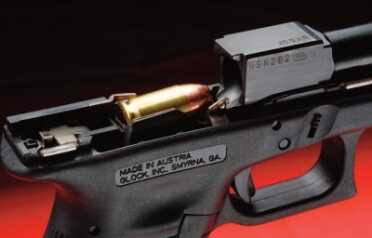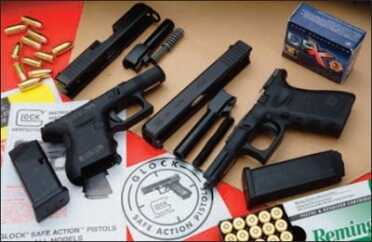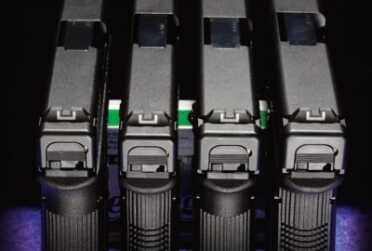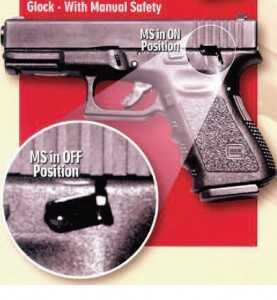
That part of the triggerguard just below the trigger will put a definite hurt on the top of your index finger. Reshape it.
Gene Shuey, Master Gunsmith, AGI Director & Instructor, gave the following overview while a guest on an AGI teleseminar.
American Gunsmithing Intitute
https://www.americangunsmith.com
AGI is an advertiser here and has also agreed to create special deals on the videos to GunsAmerica readers.
I suggest four things to anyone interested in customizing their Glock: better sights, better trigger, complete grip enhancement with a textured surface to keep it from being slick and a good aftermarket, American-made barrel. With that, you have a foundation upon which you can build for many specific purposes.
It doesn’t have to be expensive, either. Improving the trigger could cost as little as $25 and enhancing the frame to be more functional and aesthetically pleasing requires some simple tools and the knowledge you can learn in American Gunsmithing Institute’s Building the Custom Glock — Volume 1 DVD. Quality barrels are available that can easily be installed, sights can be tailored to the handgun’s mission, and an external safety is also an option.
Those who carry a Glock are the most likely to consider having it customized, but there are a few important factors to decide at the beginning. What is the gun going to be used for? This is important, because sometimes what you think you want doesn’t match the gun’s proposed use. It’s like driving a Corvette off-road. You may want a Corvette, but if you need to go off-road it’s not going to work. Similarly, certain things designed for a competition gun won’t work well when backpacking in the wilderness.
Glock Carry Guns
A lot of first-time Glock owners chose a Glock because it’s simple to use, and they’re getting a concealed-carry permit. In this case I usually recommend a better trigger, better sights and some work on the frame.
For example, the triggerguard is blocky and square, and with prolonged shooting it can really beat your index finger. This becomes an issue if you go to a shooting school and shoot a few thousand rounds in a weekend. You need a change there to make the gun more comfortable in your hand. If you plan on doing a lot of shooting, but you’re on a budget, you’ll probably want to shoot reloaded ammo. If you reload yourself, you’ll want to use cast bullets and plated bullets, but you can’t use a standard Glock barrel with these bullets.
Glock Barrels
Here’s why. Glock barrels use polygonal rifling. If you look inside one, it looks like an octagon. It doesn’t have the square grooves we call cut rifling, which is found in American rifles and handguns. They do this for several reasons. One, they use hammer-forged barrels, and it’s a much faster, easier, and less expensive process to hammer forge polygon rifling than it is cut rifling. Also, Glock was originally designed for European police and European military personnel who only shoot jacketed bullets.
They wanted to be able to shoot jacketed bullets under all kinds of adverse conditions. These conditions include dirty barrels, increased pressures, extreme fouling, and sometimes even under water, all without sacrificing accuracy. It was never designed to be a competition or sporting pistol. When it comes to firearms, the American market is quite different than the rest of the world. We have greater flexibility in that we can use the same pistol for competition, hunting and for self-defense.

Glocks come in a variety of configurations and DVDs from the American Gunsmithing Institute will help you learn how to work on each of them.
You have two choices when using an American barrel, a drop-in version or one that’s been fit by a gunsmith. If you are a gunsmith or training to be one, don’t be afraid to put in a gunsmith-fit barrel. They are not difficult to do. Glocks have a simple design, so don’t be afraid to do a little bit of experimenting. However, if you really want some advanced help, AGI offers another “How To” DVD on customizing Glocks, (Building a Custom Carry Glock – Volume 2). Combined with Volume 1, they will walk you through all phases of trigger jobs, accurizing, cosmetic work and a lot more. They will teach you a lot more than the average person or gunsmith knows about Glocks.
Frame and Grip Enhancement
There are several factors to consider for grip and frame enhancement. You want to make the gun fit your hand as comfortably as possible. You can do grip reductions, change the shape of the grip and take the finger grooves off.
The reason for removing the finger grooves is because they don’t really line up properly for most people. Another reason is because when you’re drawing the gun out of your holster or picking it up off the counter quickly, you don’t always grip the gun the way you would if you were to draw it slowly or place it in your hand.
Another thing I will often do is open up the triggerguard. In addition, the triggerguard itself is flat and has some sharp edges I modify to make it look more like a 1911 or a SIG. I also undercut the triggerguard so the hand can get higher up on the gun, which helps reduce some of the muzzle rise and recoil.
Lastly, I usually shape it a little bit differently by taking off some of the square surfaces. Most importantly, I’ll put a different texture on it.
Some people like to use skateboard tape or another nonskid, adhesive-backed material. This works great in improving your grip, but you probably don’t want to use it in a carry gun. Skateboard tape will rub and wear out the lining of your jacket, and if you have it in an inside of the pant holster, it’s going to chafe your skin and maybe even cause some bleeding. So for a carry gun, I suggest using a textured surface or a rubberized, textured, adhesive-backed material. It works well and is nonabrasive. The grip is perhaps the most important thing. If you lose your grip when you shoot, you’ve lost your sight picture and your trigger control. In a defensive situation, that can be deadly.
It’s often helpful to relieve behind and underneath the triggerguard and on the backstrap. Even though it’s not a beavertail, you can remove some polymer there and where the web of your hand fits up underneath. This helps get the grip higher, or I should say, the gun lower in your hand. By removing material there, it magnifies the effect of grip reduction without going into extreme frame modification.
There are also many ways to texture a grip. You can cut it in, you can use a heating element, you can also use a cutting wheel that’s V-shaped. Choose the method that best fits your ability.
I’ve put adhesive-backed rubber on one of my carry guns, and it works well and is very comfortable. In the volume 2 DVD we cover how you can make a template to put it on straight.
Sight Considerations
There are more options for sights than probably anything else and manufacturers continue to come out with different versions all the time. Some Glock owners have trouble with the sights because they’re basically a point-of-aim sight, or in other words a combat sight.
Night Sights
You may want to add night sights because the magazines or your buddies have you convinced they are good. But, night sights may not be the best suited for the gun’s intended use.
There are a several different types of night sights. Some are better than others. For example, some night sights have three little donut-like markings containing a tritium element. The donuts can be distracting if you are shooting in daylight.
For night sights, I prefer the Heinie Straight Eight. They look like a figure eight, one ball over another. In the daylight, you can’t see them, but at night they shine brightly, so there is no distraction in the daylight.
Fiber-Optic Sights
There are different size fiber-optic elements and different colors. Sometimes when shooters get older or have diminished eyesight they’ll use two colors, like red in front, green in back. Having a different color for the front sight makes it easier to put it in the center, equally spaced between the rear sights and even on top for the height.
The one sight I don’t recommend is called the XO or XS sight. That’s the one that was commonly used on express rifles. It has a very shallow V for the rear sight, and the front sight is a great big white golf ball.
The problem with this type is it’s hard to do precision or accurate shooting. It’s basically a point-of-aim type of sight. Most of your targets will be covered with the big white ball for the front sight. If the subject is close enough to use that type of sight, you don’t need a sight at all. That’s why I don’t recommend them.
So you basically have three different types of sights from which to choose — black sights, fiber optic and night sights. Within each one of those categories there is a great selection. For example, you can get a wide sight, or a narrow sight. This will determine how much light you’ll see between the front sight and the rear sight.
If it’s a carry gun, consider how you plan to carry. That is going to dictate the shape of your front sight. If it’s a target sight with sharp edges, when you put it in your waistband and pull, your skivvies could come out with it, you could get cut, or a little bit of leather could be shaved from the inside of your holster and end up on the front sight.
Barrel Considerations
We’ve already discussed barrels, but the heart of a gun is the barrel, so let’s consider a few more factors. If the barrel is not accurate, there is nothing you can do to the rest of the gun to make it accurate. So, if you build a very expensive gun and/or very reliable gun, or an attractive gun, or the gun of your dreams, put a good barrel in.
Think about it like an equilateral triangle. All three legs are equal and the same length. One leg of that equilateral triangle is reliability. The second one is accuracy. The third one is quality of work and distinction of appearance. Each one is equal. So, if you’re going to build a good gun, put a good barrel in.
If you use an inexpensive $90 barrel, it may be somewhat accurate, but how well is it made? What kind of material does it use? How good is the heat-treating? What is the geometry? When I say geometry, I’m referring to the locking lugs, the hood on the barrel, and the concentricity of the bore to the chamber. That’s very important. I know of several off-shore barrels and some American barrels that are very cheap. Some of these have had failures. They could split, crack or separate. That’s usually because of bad alloy, bad material or bad heat treatment. Good barrels have good rifling, their chamber is concentric, and it’s within SAAMI spec. Usually the rest of the geometry will be right on the money.
For a gunsmith-fit barrel, you will have to make some measurements and fit the hood, the length of the hood and possibly the width of the hood. The locking area, where it rides up on the locking block, may have to have five to fifteen thousandths trimmed off. You can use a mill or a file to do this.
Although any of this can be done by watching our step-by-step videos, for your first time I suggest using a good drop-in barrel. There are several. Bar-Sto makes one and KKM Precision makes a very good and extremely accurate barrel for a drop-in. I have one of the few barrel-testing machines in the country, and when I build a high-end gun, I will select the barrel from the manufacturer and test it.

Here’s a look at some of the different widths, sizes and configurations in Glock grips. With the right one you’ll shoot faster, more accurately and pain-free. It’s worth every bit of the cost, time and effort.
Trigger Options and Aftermarket Parts
There’s also a wide variety of options when it comes to triggers. This creates a problem because the average guy off the street will pick up a catalog and purchase a brand X connector, brand Y springs and try to use it with his brand Z trigger bar. He puts it all together and guess what? It doesn’t work.
It doesn’t work because of the different geometry. A Glock is not a precision gun, but it will always go bang by using the Glock design and parts. We Americans want precision, accuracy and speed, so we start playing with the geometry, replacing Glock parts with aftermarket parts. It’s a crapshoot whether it will work or not.
Here’s what I do to solve this. I buy parts and I have companies send me parts, and I test them. I will mix and match and find the idiosyncrasies of the mixed and matched parts. It can get really confusing because you also have different generation Glocks and some aftermarket parts work better in some than others. Even if there’s nothing wrong with the parts, they just don’t all work well together.
Instead of replacing all the trigger parts, I recommend modifying or enhancing the existing parts. That avoids the problems of using mix-and-match parts. In this case, instead of replacing everything, the only two areas changed are the three springs and the connector. We’re going keep everything else the same, but you, as the gun owner, are going to polish the parts. It’s really simple. It’s going to give you a 90 percent better trigger that works great, but costs less than $25.
Isn’t that better than spending $300 for sophisticated trigger bars, metal triggers with over-travel screws, with different connectors and ending up with a five percent better trigger?
Not only is the trigger going to be better, but it’s going to be reliable, and that’s the key to a carry gun. Changing out the springs and the connector, polishing it the right way and in the right places, is going to give you a great trigger that will go bang every time you want it to go bang.
You can learn how to do this, as well as a grip enhancement, in the video courses. All you need are some very simple tools – a Dremel tool with a couple of sanding drums and a file.
Thumb Safety
There are some real advantages to the Cominolli thumb safety. With this thumb safety, when you have it on, you
can’t pull the trigger. But you can still load and unload the gun and work the slide, which means you’re not going to have an accidental discharge.
Some Glock purists cringe at the idea of putting an external thumb safety on a Glock, but we are simply making it safer. The Glock warranty is not voided, either, so it’s something to consider.
Conclusion
Along with the things we’ve already discussed, other fairly easy things to do are extended mag releases and extended slide releases. Glocks aren’t difficult to work on and the sky is the limit in regard to what you can do to them.
And don’t forget to take advantage of AGI’s special deals on the videos, exlusively for GunsAmerica readers.
*The American Gunsmithing Institute also offers a full gunsmithing course for those wishing to pursue this interesting career.



I switched from shooting revolvers(carry and competition) to carrying the Glock (LE, open and concealed carry). I changed the sights. Period. I was taught as others that in the case of a shooting you do not want your pistol to be modified. It took some rounds down range to get used to the trigger, but would not change it. Have been carrying my Glock for 23 years and have never had any problems or concerns with it. I’ve also shot hard cast lead bullets through it(cleaned well afterwards) and have not had problems with the polygonal barrel. Why change a good thing?
hey , glock is the best one i have every used as it is , is it worth modifying the gun and changing the settings that much?
I would like to say at first I looked at these pistols and thought they looked square and ugly. But I had a choice to get one…boy was I misstaken..this guns are great and very acurite. Know I love this pistol..I have the model 17L and I have 5 of the 17rounds plus two on my mags. What a great pistol…changed out my barrel for the LONE WOLF to shoot lead rounds…but I have my old barrel. thank you GLOCK ..you saved my life more then one time. GOD BLESS THE MEN THAT DIED FOR FREEDOM… THANK YOU GLOCK.
I’m not a LEO, but do carry. The one thing I needed to do to my Mod. 21 was remove the finger grooves and sand down the backstrap. I have large hands and until I did that I could niot get a comfortable hold on the pistol. As far as internal mods, I leave it alone. The trigger pull is nit bad ande it’s reliable. When I have some extra $$, I will probably rework the sights. It doesn’t need anything else.
I have one Glock with some modifications, it makes the trigger slightly better, just for target shooting. I do NOT use it as my carry gun, I have a factory stock Glock for that. Like the others have said, buy more practice ammo, and practice. I thank Massad Ayoob for that excellent advice many years ago.
There is nothing wrong with modifying a GLOCK for play use, such as competition our just general plinking, but if it’s the gun you carry and rely on for self defense, leave it stock. That being said, the author didn’t say anything that was incorrect, I just disagree with his opinion on modifying a duty weapon.
I agree with the above two posters, as a carry gun why put a thumb safety on a Glock, it defeats the purpose.if you are that uncomfortable with the Glock internal safety’s do one of the following 1 carry it un chambered (not recommended to any LEO) 2. Get another gun with a thumb safety there are many good ones on the market.
Note I’m a former LEO and training instructor now retired
I agree 100% with the above comment. I customize Glocks for a living and advise that only sights be changed for defensive carry. In our anti-gun culture, you cannot protect yourself enough. Prosecution will prey upon the average person’s ignorance to bring their paycheck.
As a retired LE Officer with over 25 years of Glock firearms training experience, and a state certified Concealed Carry Instructor, I must take exception to the advice offered in this article regarding modifications to the Glock platform.
The author is correct in every technical sense, and his advice regarding the possible modifications to the platform are valid when considering a Glock slated for “competition”. However, I would not modify the trigger, barrel or frame on any Glock to be used for defensive carry…sights yes…the other mods, no way.
In the event of a self-defense shooting, a zealous prosecutor and or a tenacious personal-injury attorney, could make the argument that a modified Glock was intended as a more “efficient killing machine”.( their words not mine) While such an assertion may seem ludicrous, these type of “jury baiting” techniques are very real and in many “gun unfriendly” states, prevalent.
After training thousands of police officers as well as civilians, the overwhelming majority of students/customers would be better prepared for an armed encounter by using the extra money slated for custom modifications, to purchase extra practice ammunition and obtain advanced instruction from a certified trainer.
And. just to add a final note; if the reader feels I am off-base with this observation, don’t take my word for it…ask Clint Smith, Massad Ayoob, Rob Pincus, or any of the Nationally Recognized Firearms Instructors…all of whom will tell you the same thing.
Stay safe and practice more!
I work for WeaponstrainingSchool as an RSO and we teach the same thing in all our concealed carry courses. Do not modify other
than sights! My question for you is what you recommend as the best night sights available. Good eye relief really helps me.
I was also considering trying out some competition shooting. I see glockmeister can modify the glock 34. Any advice or should I
look to another brand? Thanks, Joan Marie